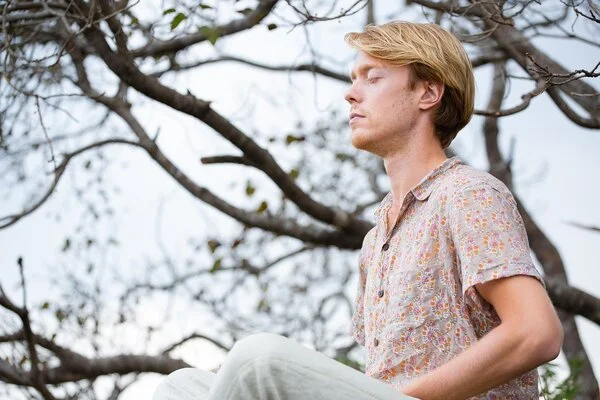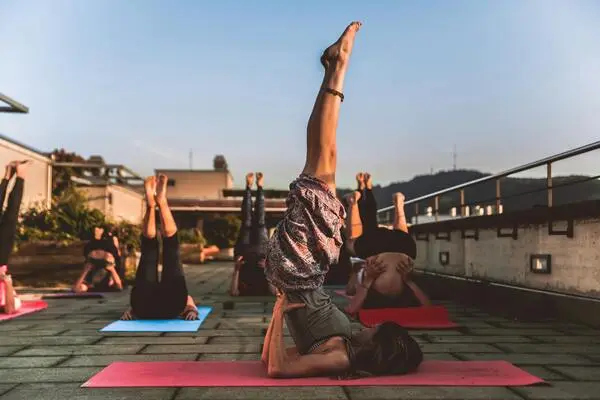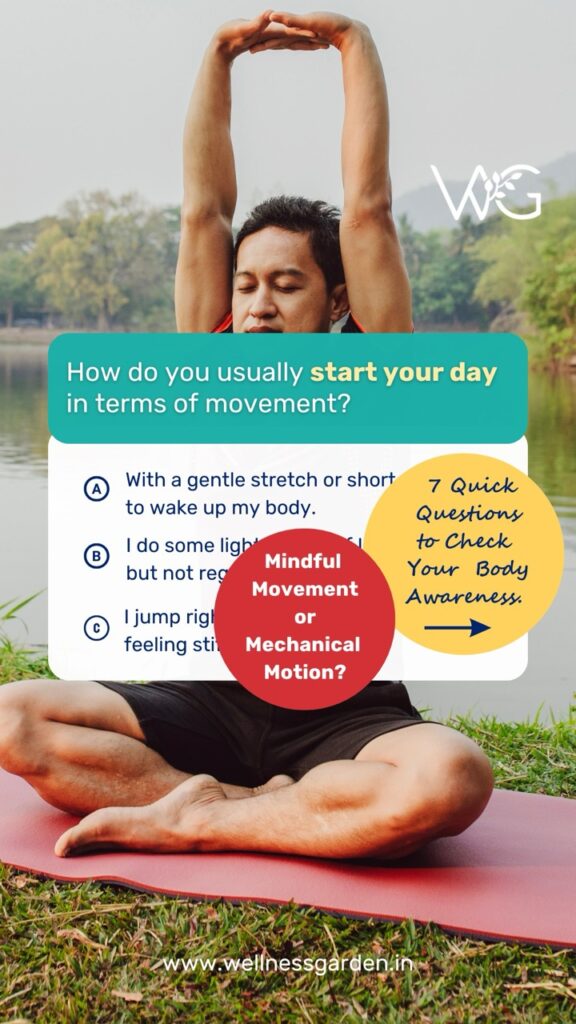Heal with Yoga: Every Breath, A Step Towards Balance
- Movement
- 3 mins
- August 9, 2023
- Ashutosh Mishra
- Strength Training, Yoga & Meditation
Beyond its reputation for stress reduction and improved flexibility, yoga asanas offer an unexpected treasure trove of health benefits. Among these, the potential to conquer chronic pain stands out.
If you find yourself grappling with persistent back pain, the answer might lie in the gentle yet transformative heal with yoga. By integrating simple yoga asanas into your routine, you could bid farewell to that nagging discomfort and reclaim life in full swing.

Embrace the Healing Path: Yoga for Back Pain
Is your back crying out for relief? It’s time to give yoga a chance. Scientific studies have unveiled the remarkable efficacy of this ancient practice, where stretching, strength-building, and flexibility converge to alleviate back soreness. The evidence is compelling: yoga can surpass conventional treatments in enhancing back function. Recent research even reveals that individuals participating in yoga or stretching classes are twice as likely to reduce their dependence on pain medications compared to those who tread the path of managing symptoms alone.
Heal with Yoga Asanas for Back Pain

Asanas are performed to address the structural problems in the joints and the spine as a whole. They can be therapeutic or preventative. They keep the muscles in good tone and prevent contraction so that the muscles can allow complete movement and lubrication of the joints. The forward, backward, and sideward bending asanas mobilize the inter-vertebral joints, develop the supporting musculature of the spine, strengthen the ligaments, and massage the nerves and blood vessels. These are essential if proper spinal health is to be maintained, especially in the middle and later years of life. Because of this, development and maintenance occur equally on each side, and the possibility of unequal tensions on the spine is reduced. These asanas should be practiced for 15 to 20 minutes each morning without fail, followed by 10 to 15 minutes in shavasana/adavasana. These asanas are specifically designed to increase the functional efficiency of the various muscle groups responsible for back pain and should be learned under expert guidance.
Asanas for the Lower Back Muscles
1. Makarasana (crocodile pose)
Lie flat on the stomach raise the head and shoulders and rest the chin in the palms of the hands with the elbows on the floor. Relax the whole body and close your eyes. Maintain the natural and rhythmic breathing for 10 -20 rounds in the final posture.
Awareness: on the breathing process with a concentration on the lower back and relaxing the whole body.
2. Bhujangasana (cobra pose)
Lie flat on the abdomen with the legs straight, feet together, and the soles of the feet uppermost. Place the palms of the hands flat on the floor below and slightly to the side of the shoulders. Fingers together and pointing forward. Rest the forehead on the floor. Slowly raise the head, neck, and shoulders, and raise the trunk as high as possible. Use the back muscles more than the arm muscles. Arch the back, and tilt the head back. Pubic bone remains on the floor, naval raised to a maximum of 3 cm. To return, slowly bring down the head. Relax the lower back muscles. Inhale while raising the torso, breath normally in the final position, and exhale while lowering the torso.
Awareness-: breathe with the movement and the smooth, systematic arching of the back.
3. Ardha Shalabasana (Half locust pose)
Adopt the position of the advasana (or the reverse corpse pose). Bring both hands under the thighs with palms facing upwards/downwards, chin on the floor. Inhale and raise the left leg. Hold your breath and leg in the final position. Exhale bring down the left leg and continue three more rounds on the same leg. Repeat the same with the opposite leg. Practice for 2-3 rounds.
Awareness: Synchronization of breath with the leg movements as well as on the lower back muscles.
4. Tadasana (Palm tree pose)
Stand with the feet together or about 10 cm apart and arms by the sides. Raise the arms over the head, interlock the fingers, and turn the palms upward. Place the palm on top of the head. Fix the eyes at a point. Inhale and stretch the arms, shoulders, and chest upward. Raise the heels coming up onto the toes. Stretch the whole body from bottom to top, without losing balance. Hold the breath and the position for a few seconds. Lower the heels while breathing out and bring the hands to the top of the head. Relax for a while and repeat the practice 5-10 rounds.
Awareness: synchronization of breath with body movement, maintaining balance and stretch of the whole body.
5. Balasana (child’s pose)
Child’s pose or balasana is one of the most effective asanas that helps to relax and recharge the muscles of your back. This pose not only helps release tension from your back but also calms your mind.
Place your knees on the floor and rest your buttocks on your feet. Keep your back straight and your hands resting on your knees. As you exhale and while using your hands as support, slide down and forwards. While you are down, breathe in and out slowly and relax your entire body. Hold this pose for some time, and rise slowly to come out of the pose.
Other asanas like shalabhasana, ustrasana, etc. are also to be done.
Asanas for the Shoulders and Upper back muscles
Start heal with yoga Asanas for shoulders are as follows:
1. Skandha Chakra (Shoulder socket rotation)
Adopt any comfortable cross-leg sitting position. Place the fingers of the right hand on the right shoulder. Keep the left hand on the left knee and back straight. Rotate the right elbow in a large circle. Practice 10 times clockwise and 10 times anti-clockwise. Repeat with the left elbow.
Stage 2: Place the fingers of the left hand on the left shoulder and the fingers of the right hand on the right shoulder. Fully rotate the same elbow at the same time in a large circle. Try to touch the elbows in front of the chest in the forward movement and touch the ears while moving up. Stretch the arms back in the backward movement and touch the sides of the trunk while coming down. Slowly practice 10 times clockwise and 10 times anti-clockwise.
Inhale – Upward stroke, Exhale – Downward stroke
Awareness: On the breath, mental counting, and the stretching sensation around the shoulder joints.
2. Sarpasana (snake pose)
Adopt the position of the advasana. Place the chin on the floor. Interlock the fingers and place the arms and hands on the back at the level of the spine. Chin on the floor, using the back muscles raise the chest from the floor push the hands further back, and raise the hands as high as possible without straining. Hold for a comfortable time slowly return to the savasana and relax the body. Inhale before raising the chest; retain the breath while rising and in a held position exhale while lowering down. Practice for 2-3 times.
Awareness: on the breath and contractions of spinal and arm muscles.
3. Marjariasana (cat stretch pose)
Marjariasana is excellent for improving the flexibility of the spine. Sit in vajrasana, raise the buttocks, and stand on the knees. Lean forward and place the hands flat on the floor beneath the shoulders with fingers facing forward. The thigh perpendicular to the floor is the starting position. Inhale, raise the head and depress the spine, the back becomes concave. Exhale; lower the head and stretch the spine upward.
Practice for 5-10 rounds.
Awareness: on breath with movement and flexion of the spine from top to bottom.
4. Gomukhasana (cow pose)
Try gomukhasana or cow pose to get rid of that niggling back pain. This pose is typically done by putting all your weight on your knees such that your upper body is erect helping you strengthen the muscles that support your spine.
Bend your knees and place them on your yoga mat such that your upper body is erect and all your weight is on your knees. Take your right hand bend it at your elbows and place it behind your back. Now take your left hand above your head while bending it at the elbow above your head. While placing it at the nape of your neck, try to grasp your right hand with it. Breathe normally and bring down your hands to the starting position.
Awareness: on breathing with movement.
Other asanas like Dwikonasana, Kandharasana, etc. are also to be practiced.
Pranayama and Relaxation techniques
Use relaxation and pranayama to reach your full potential for holistic wellness. To help you manage and relieve discomfort, these 3 types of practices go above and beyond the usual techniques. Explore the world of relaxation and mindful breathing, where age-old knowledge melds with present-day demands.
1. Pranayama
A combination of practices is vital in the management of back pain. Pranayama techniques help pump lymph and remove toxins from the site of inflammation. They assist in the movement of the cerebrospinal fluid that bathes the nervous system and keeps it healthy. Abdominal breathing and full yogic breathing activate the abdominals and massage the spine from the inside, especially when done lying prone as in advasana, jyestikasana, and makarasana. Pranayama requires forced exhalation and agnisar kriya works on many of the postural muscles especially the pectorals, back muscles (latissimus dorsi and anterior serratus), and the abdominals. Agnisar kriya also helps activate and clear the bowels.
2. Relaxation in Shavasana or Advasana
Shavasana (corpse pose)
Lie down on the spine with the arms and legs slightly apart, Palms facing upwards. Eyes and lips gently closed. Head, neck, and spine straight in a line. Relax the whole body and stop all the physical movements.
Awareness: on the natural breath as well as on the relaxation in the whole body.
Advasana (reversed corpse pose)
Lie on your stomach. Stretch both arms above the head with the palms facing downward. The forehead should be resting on the floor. Relax the whole body, become aware of natural breath, and allow it to become rhythmic and relaxed. This asana acts as a base position in most of the recommended practices for backache.
Awareness: on the breath and relaxation in the whole body.
Visualization of tight, congested back muscles relaxing, letting go of tension, and flushing the area with fresh blood. Pranic energy is visualized flowing into the back muscles in conjunction with the breath.
3. Shatkarmas (cleansing practices)
Constipation and impaction of the feet are common with chronic back pain. The removal of all fecal matter often brings pain relief. The practice of lagoon or poor shankhaprakshalana is important once the body is strong enough to do the asanas.
Benefits of yoga in back pain
- Posture: Heal with yoga exercises strengthens the back and abdominal muscles and helps the body maintain a proper upright posture and movement.
- Relaxes: Alleviates Tension in Stressed Muscles. Well-conditioned muscles not only help alleviate stress but also contribute to mitigating back pain.
- Improved Circulation: This Vedic method increases blood circulation to prevent the accumulation of lactic acid.
- Alignment: Through heal with yoga and asanas, you can maintain a natural curvature of the spine that is crucial in avoiding lower back pain.
- Ligament Injury: Besides any kind of medication, heal with yoga itself is an excellent therapy for increasing the strength and flexibility of joints so it is recommended to those patients who suffer from ligament injury.
- Lubrication: If you follow a proper yoga regime it gives lubrication of the joints, ligaments, and tendons.
- Toning: It helps in toning up your back muscles.
- Spinal Flexibility: By regular practice of yoga asanas, your spinal joints will find a proper healthy way to get rid of the stiffness of the joints.
Warnings
The incidence of spinal problems will be greatly reduced when those following a sedentary lifestyle, unused to back exercise or strain, learn to practice a few and heal with yoga asanas daily to preserve strength and flexibility of the spinal muscles, discs, and ligaments. Avoiding excessive use of chairs and backrests which weaken the back muscles and learning to lift a heavy weight from the floor correctly, that is, from the squatting position with knees bent, to protect the vulnerable lower back from excessive strain and injury will also preserve a healthy back.
Note: The above said heal with yoga kriyas should be practiced under the supervision of a competent yoga teacher. If you have a slipped disc in the lower back or sciatica, please avoid all deep forward bends as these can make your condition worse.
If you’re interested in practicing the aforementioned yoga kriyas under our guidance, feel free to get in touch with us for personalized Yoga Consultations and more.
A Word From WG
Wellness Garden is your committed partner in seeking comprehensive natural and holistic therapies to address all your pain and wellness requirements. Our approach encompasses the entirety of your body, mind, and environment, integrating body, mind, and nutrition therapy and various other techniques.
Whether facing physical or mental health concerns, life hurdles, or simply aiming to enhance your overall well-being, we’re here to provide the support you need. Get in touch with us to explore the possibilities and embark on your journey towards holistic therapy and improved health.
This article, authored by Ashutosh Mishra, a Yoga Consultant, was originally published in Amruth Heritage Magazine and is being shared here by Wellness Garden. If you’re looking for more insightful articles on wellness, yoga, and holistic health, feel free to reach out to us.
Stay connected for more enriching content and tips to lead a balanced and healthy lifestyle.
- Table of Contents
- • Introduction
- • Yoga for Back Pain
- • More Asanas
- • Breathing techniques
- • Benefits & Warnings
- • A Word From WG
Recent Posts
Join Our Newsletter
End note from WG Team
Ashutosh Mishra
Yoga Consultant, Amruth Heritage Magazine
Take the next step in your wellness journey. Discover how our curated non-allopathic therapies can complement newfound knowledge at www.program.wellnessgarden.in or reach out for personalized guidance to our team at info@wellnessgarden.in.
Disclaimer: This information is provided for educational purposes and should not be construed as medical advice. Please consult with healthcare practitioners before undertaking any changes in wellness routines or adding new therapies.
Latest Blogs
Check out some of your blogs related to your interest.
- June 21, 2025
- Rodney Yee
- 3 Mins

- June 14, 2025
- Harvard Health
- 3 Mins

- April 13, 2025
- 2 Mins

- March 30, 2025
- Dr. Aviva Romm, MD
- 4 Mins






